Nothing is moving in the parched valley bowl below except for the whirling dust blown this way and that by the hot summer wind. What water there is is slowly evaporating, leaving behind it only cracking mud, baked hard underfoot. Sandblasted, desiccated vegetation provides the only shade, and there’s very little of it. The temperature is 31deg C and climbing. This, believe it or not, is rural Leicestershire, and never has it looked quite so inhospitable.
There isn’t a scrap of asphalt to be seen. Instead, the landscape offers only steep tracks, rocky crawls and craggy descents much too perilous to be negotiated in anything less than the most capable four-wheel-drive passenger vehicles on the planet. As it happens, however, that’s just what we’ve got – and we’re here to find out which tops the pile.
There’s no tougher pair of four-wheeled opponents for the all-new Land Rover Defender than the Jeep Wrangler Rubicon and Mercedes-Benz G-Class. As you’ll probably already have read, these are rivals that both offer precisely what the new-generation, monocoque-underbodied Land Rover has just given up in its rush towards well-mannered modernity: a ladder-frame chassis, solid articulating axles and a degree of compactness that has fallen well out of fashion with the makers of today’s luxury SUVs. What difference will that make, I wonder? We’ll find out in a while.
But before my colleague Matt Prior takes over to tell you all about how these cars compare off road, I’m to fill you in on what driving and using them in daily life might be like. And if Gaydon’s decision to move its off-roading icon from a traditional separate-chassis construction to a unitary one and replace articulating axles with independent suspension is to pay off, it ought to be on ring roads and motorways rather than on rough tracks and mudslides. As we’ll find out, it does that – loudly and clearly, in fact. But that’s not all that would make the new Defender more usable, driveable and pleasant than either the Mercedes or the Jeep in everyday use.
We’ll start in an obvious but nonetheless important place. Driving anything the size of cars such as these means first getting in. It’s the G-Class that makes you climb highest, stepping first on that chunky chromed running board on your way in. It’s really not unlike getting up into the cab of a lorry.
Both the Defender and Wrangler can just about be entered directly from the ground, the Land Rover by virtue of the lowered ‘access’ height of its standard air suspension (which disguises its size quite cleverly in the process), and the Jeep just because it’s a slightly lower-riding, leaner vehicle than either of the others. The Jeep would, in fact, probably be the easiest car to get in and out of full stop, if not for its chunky door sill. You have to hitch your left leg right up and out straight to negotiate it, as if hurdling a low fence – and then once you’re in, the driver’s footwell feels narrower and more confined than you might be expecting.
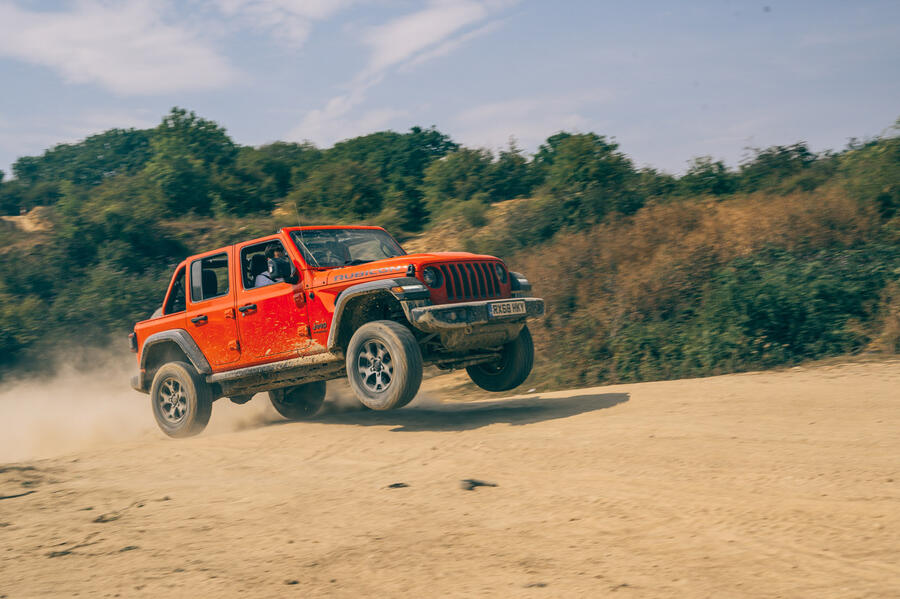
Furthermore, there are surprisingly stark differences between the high-tech, chrome-rich luxury of the Mercedes, the big-buttoned, many-levered, chunky plainness of the Jeep and the smart-yet-functional simplicity of the Land Rover. For its price, the ritzy G-Class ought to have the most appealing cabin here by a country mile, but while its interior certainly feels special, the Defender has it clearly beaten for spaciousness in both rows. The space is also a lot more versatile, much better provisioned with power outlets and storage cubbies to cope with the demands likely to be made of it by modern life.
The Defender feels like the first big 4x4 we’ve seen in years, in fact, in which everyday functionality has been given design priority over almost everything else. It has the only rear bench seat here on which three adults could comfortably fit, and it’s the only car here with an optional third row. And while all three cars have side-swinging boot ‘doors’ to which their spare wheels are fixed, it’s those of the Defender and Jeep that are hinged on the convenient side for UK on-street kerbside loading.
When parking the G-Class on the street, by contrast, you’d be searching a long time for a parking space nearly double the length of the car itself, in order to leave not only enough space to open that rear door but also enough to be able to walk past it with bulky items of cargo before loading them. Either that or be content to leave it awkwardly pointing the wrong way up the wrong side of the street.
And as to what actually driving these cars day to day might be like, on those office commutes, family outings, Saturday shopping trips and (dare I suggest) school runs? Well, it’d be ‘a big shout’ in any of them, wouldn’t it? Even in these SUV-obsessed times, there are those in certain parts of the country who will look at a Defender, Wrangler or G-Class driver and see a stark raving sociopath, and nothing about how you use it, where you drive it or where you park it would probably change that much. The sheer size of the Land Rover, the unashamedly boxy look of the Mercedes and the rugged visual flourish of the Jeep would invite tutting criticism in equal measure, I suspect, yet there are things to love about the look of all of them.
Put your tin hat on, then, and you’ll find there is broadly similar on-road performance and driveability in these cars. Being the heaviest car here, the G350d probably needs its 282bhp 3.0-litre six-cylinder diesel motor; it’d be the car you’d pick for heavy-duty towing, thanks to its surfeit of low-range torque. But the 237bhp 2.0-litre Defender wouldn’t be too far behind (the 197bhp 2.2-litre Wrangler is only rated to tow a maximum of 2500kg). None of the cars is quick, typically, but all are quick enough. And all are so much easier to drive on the road and more pleasant than ‘proper off-roaders’ ever used to be. They have fairly slick and smart-shifting automatic gearboxes and steering that’s entirely manageable for both weight and pace, as well as respectable high-speed stability, at-worst passable mechanical refinement and equally decent levels of body control and outright grip.
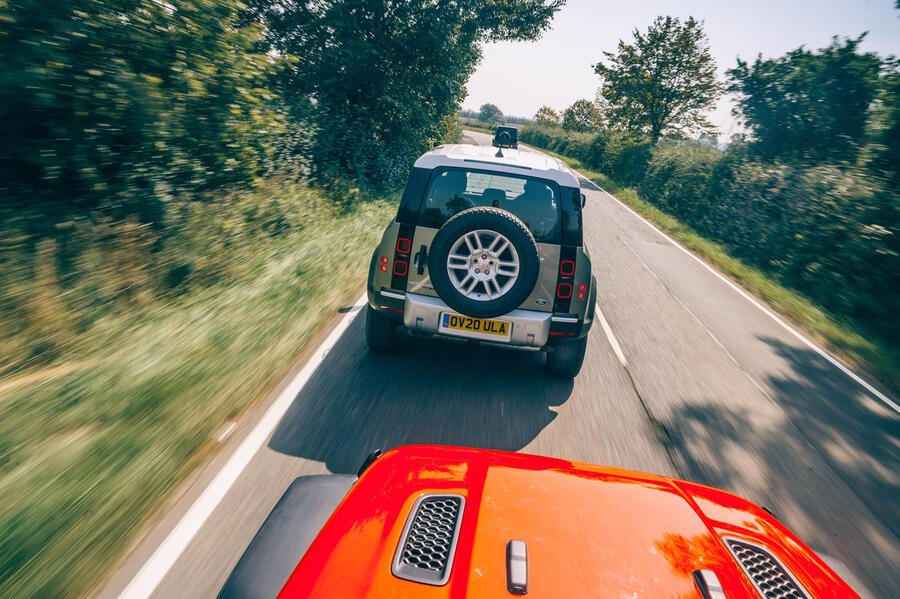
Still, due in part to the particularly aggressive off-road tyres associated with its hardcore Rubicon specification, the Wrangler feels just a little uneasy on the road, because it needs to be steered all the time. It’s a car you guide at A-road and motorway speeds with continual corrections five degrees either side of the path you intend to take.
The G-Class can feel just a little uneasy, too, but in this case because it rolls further and harder than either of the other two when cornering. Hurrying it around a traffic island will set the front tyres squealing long before you think they should, while lumps and bumps that wouldn’t really disturb most modern passenger cars can upset both its rear axle and its body control noticeably.
The Defender’s tyres don’t squeal around roundabouts. It doesn’t wander its way down B-roads. Its ride is as quiet and composed as that of a great many other big 4x4s, its body control is assured, its steering linear and pleasingly precise. That upright windscreen profile and those large door mirrors do make for a little bit of wind noise on the motorway, and both the air suspension and eight-speed automatic ’box have occasional moments of clunkiness. Thankfully, though, they are seldom the same moments, or serious ones.
All things considered, the new Defender conclusively dominates its extra-rugged 4x4 rivals for space and habitability. It dominates them for versatility, too, and for on-road ride refinement and handling sophistication. Land Rover must have known that it would.
The next bit, however – the naked, dusty, scrabbling truth about its trademark ‘best 4x4 by far’ off-roading ability – was always going to be tougher to predict. Matt Saunders
Off road
Saunders is right, you know, about the heat and the dust. Last winter I drove a Ford Ranger Raptor through the lake in this quarry and – 850mm wade depth notwithstanding – nearly drowned it. I had to open the door to let water pour out of it.
Today, if I were so inclined, I could drive through the same spot without doors altogether. And with the Jeep I literally could – because you can remove them wholesale, as we did with the roof; it involves eight bolts and five minutes’ work.
The ability to do all this, plus the sight of the roll structure they leave behind, gives you an idea of what the Jeep is for. It was made for larking around where it’s rough underfoot. (See also the big plastic wheel arch extensions.) Cost, packaging and construction ease gave the Jeep those trademark wing shapes in 1941, but the fact that you can nerf rocks off road without damaging the metalwork is a sign of its intent.
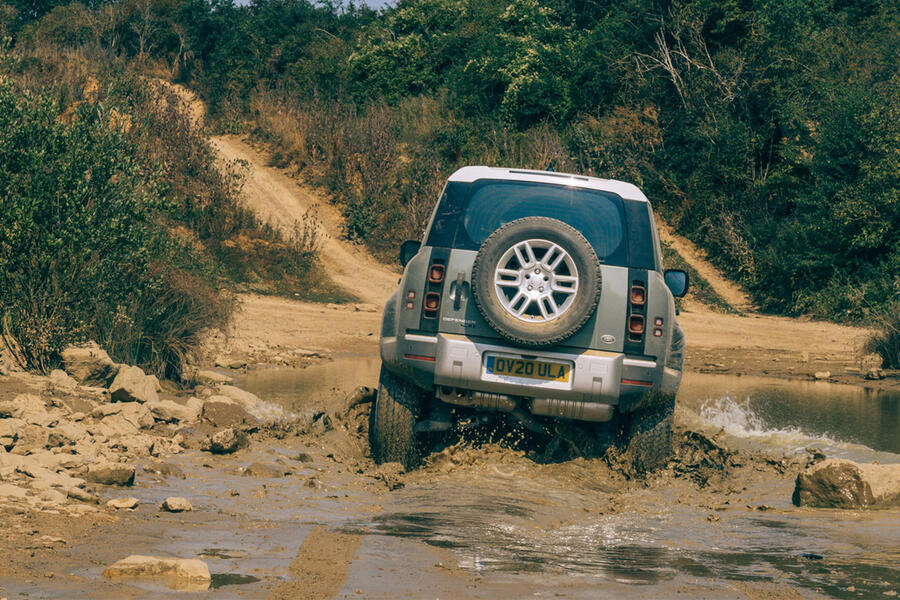
So let’s begin inside it. Or, should you be inclined to drop the windscreen too, pretty much on top of it. This Rubicon variant is the most hardcore Wrangler, so it gets uprated axles, ultra-low-ratio crawl gears and super-aggressive BF Goodrich tyres. (The other cars have less off-road-focused rubber, so we’ll try to devise routes and tests that remove tyre ability – the biggest factor on whether a car will make it through terrain or not – from the equation.)
From the Jeep driver’s perch, it’s easy to see its edges, and it feels, in this company, relatively compact. All three cars get usefully large mirrors, making their overall widths similar, but here, between ruts and undergrowth, body width is more relevant, and the Wrangler, at 1.87m, gets a competitive advantage over both the 1.98m-wide G-Class (although at least some of that width is made up of plastic wing covers), and the Defender, on which wheel arch guards would cost £599 and then add to the 2.04m body width. If you know the old Defender, you’ll be struck by the fact that this is now the widest and tallest car here.
How much does that matter? Like any other number, it depends where you are. If a pair of gateposts is 1.88m apart, then quite a lot. Tyres and the efficacy of these cars’ four-wheel drive systems count for more, but don’t underestimate the numbers, because in severe terrain there’s probably one that will determine ease of progress. A 4x4’s approach angle is its approach angle, and if a hard rock exceeds it, the car will nose into a bank. The relevant figures are all over the page.
They’ll tell you that, on account of its air springs giving ground clearance of 291mm, the Defender puts more space between itself and the surface below. To that, you can add that it has independent suspension all around; this means, because it doesn’t have solid axles, that the differential doesn’t hang in the middle (a measurement not included in the ground clearance). Instead, there’s more metal hanging towards the edges of the body, something generally considered less rugged in markets where people do a lot of rock crawling and bashing. But in wetter climates, where there are lots of muddy ruts, you’d rather have ground clearance in the middle of the car to avoid grounding. The Jeep gets two solid axles – so it’s easy to fit a lift kit to it, as is common in the US – while the Mercedes has one of each.
You might be noticing, then, that “Which is best off road?” is a question ultimately answered with “It depends what you’re doing”. The Land Rover wades the deepest and rides the tallest, the Jeep is the most manoeuvrable, can disconnect its front anti-roll bar for big axle articulation, has the tightest body control when leaning and is the lightest by a big margin, so it’s least likely to sink into soft ground. Meanwhile, the Mercedes has good numbers all round and three lockable differentials.

Ah, differentials. Part ‘x’ of the great off-road equation. The thinking is simple: when a wheel is unloaded, it can spin. If you lock a differential, each wheel gets 50% of that axle’s torque all the time, so the grounded wheel receives grunt. Lock a centre diff too and each axle splits the torque – so in the G-Class, each wheel can have 25% of overall torque, which is probably plenty to keep moving. Front and centre of the G-Class’s cabin are three switches, then. This Wrangler has two: front and rear.
The Land Rover has none, because it automatically locks and releases its centre diff, dependent on terrain, and while you can specify an active locking rear differential, this car doesn’t have it. Instead, there’s Land Rover’s Terrain Response system, which combines throttle response, stability control and ESC systems.
There’s method to this, instead of just fitting a locker, too. By braking individual wheels, the Defender can give any single wheel more power than the equal amount allotted by a locked diff, and different off-road programs tweak that. It also removes a question for the driver. Where the Wrangler and G-Class leave you to push buttons, the Defender works it out itself. An available array of external cameras makes seeing obstacles easy. And its light steering seldom locks up or tugs when the wheels are loaded, as it can in the Jeep and Mercedes.
So the Wrangler is a 4x4 hobbyist’s car. The Defender tries to take on the heavy thinking for you and is therefore the least tiring. The G-Class shares their capabilities and has an involvement level about halfway between the pair. On our day, then, the Jeep’s underbody grounded most, but it kept its wheels grounded most too, and it found easy traction when they were lifted. The Defender hit its underbody least but, when a wheel was off the ground, made slower progress by having to brake an airborne wheel first. The G-Class, meanwhile, had a bit more underbody trouble than the Defender but absolutely no traction dramas.

And so it goes. Find an individual obstacle and you’ll be able to say which 4x4 is best. But on a long route, it could be any of them – and by winching, pulling or hacking at things, you’d get them all through the same terrain in the end.
The only question, really, is which one you’d rather do that in. Purely off road, for its involvement, manoeuvrability and potential for roof-off, doors-off larks, I’d choose the Jeep. But it wouldn’t get me any farther than the others. Matt Prior
Off-roading angles compared
Those numbers in full, then. Note that the Defender has air springs, which mean it can be lifted into an off-road mode, in which it dominates the underbody angles.
The respective approach angles are Defender 38deg, Wrangler 36deg, G-Class 31deg.
Breakover (ramp) angles are Defender 28deg, Wrangler 20.8deg, G-Class 26deg.
And departure angles are Defender 40deg, Wrangler 31.4deg, G-Class 30deg.
The Defender also has the best ground clearance (measured to the body between the wheels, rather than to the axles). So Defender 291mm, Wrangler 252mm, G-Class 241mm.

The Defender should ground less than its rivals, then, and it can also wade deeper: Defender 900mm, Wrangler 762mm, G-Class 701mm.
Then there are other stats, like the towing limit, vehicle weight, body width. Overall height plays a part, too (Defender 2.00m, Wrangler 1.87m, G-Class 1.98m), as does turning circle (Defender 12.8m, Wrangler 12.2m, G-Class 13.6m).
We tried to limit the impact of tyres on our tests, because the Jeep’s were the most aggressive and you can choose to spec more hardcore off-road tyres for the other two. For the record, on our day the Defender had Goodyear Wranglers, the Jeep came with BF Goodrich Mud Terrain KM2s and the G-Class wore Falken Wildpeak ATs.
READ MORE
New Land Rover Defender: UK prices confirmed for 90 and 110
Land Rover Defender 110 D240 S 2020 UK review

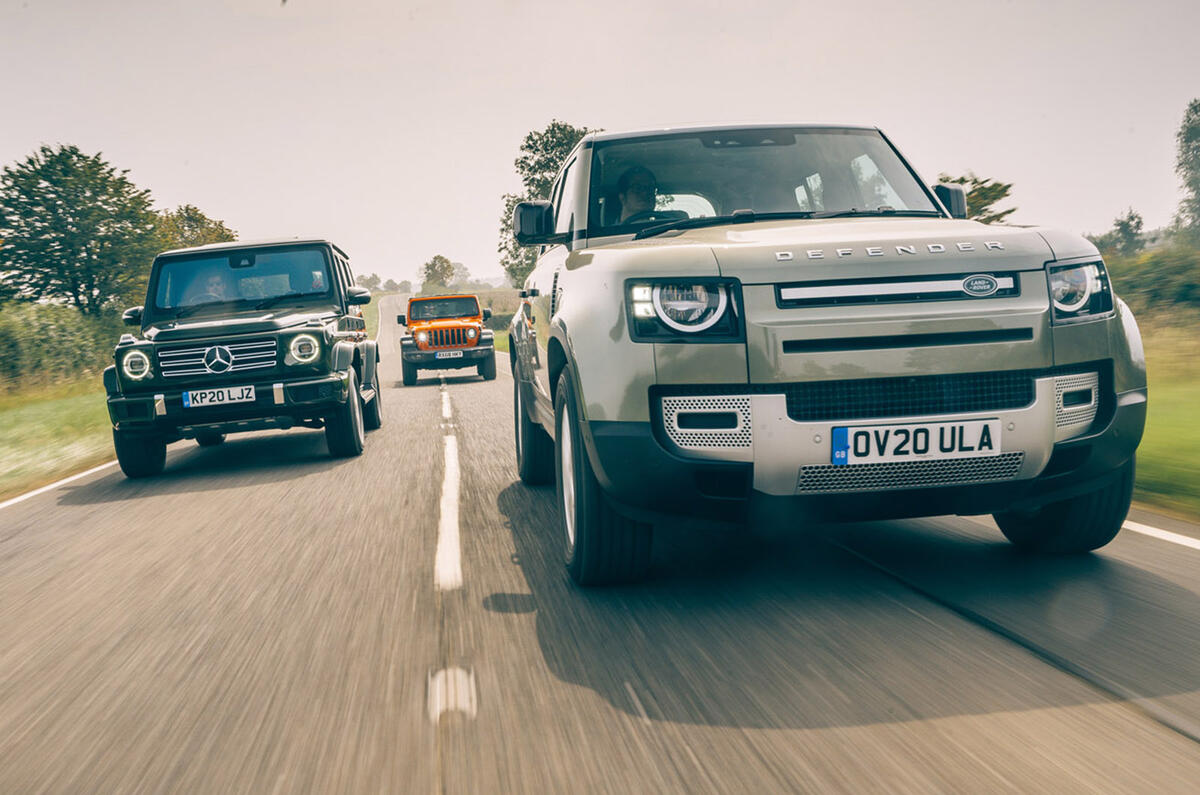







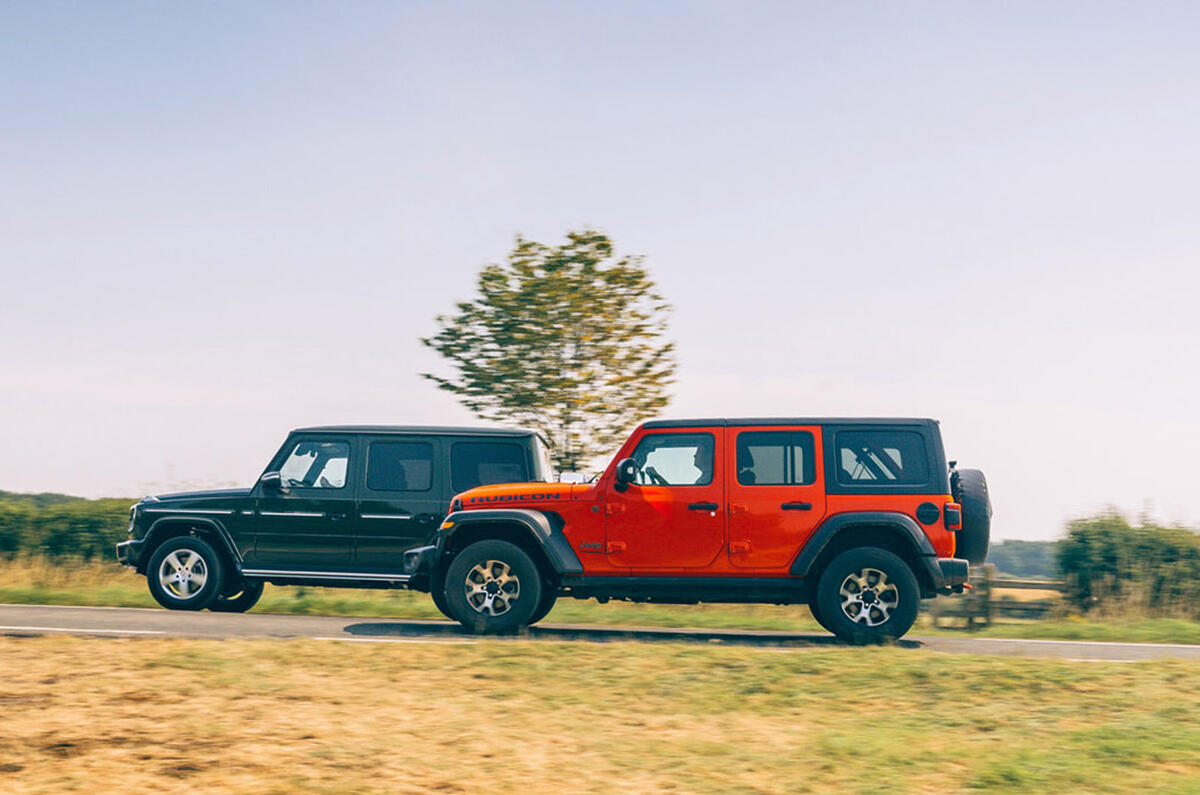
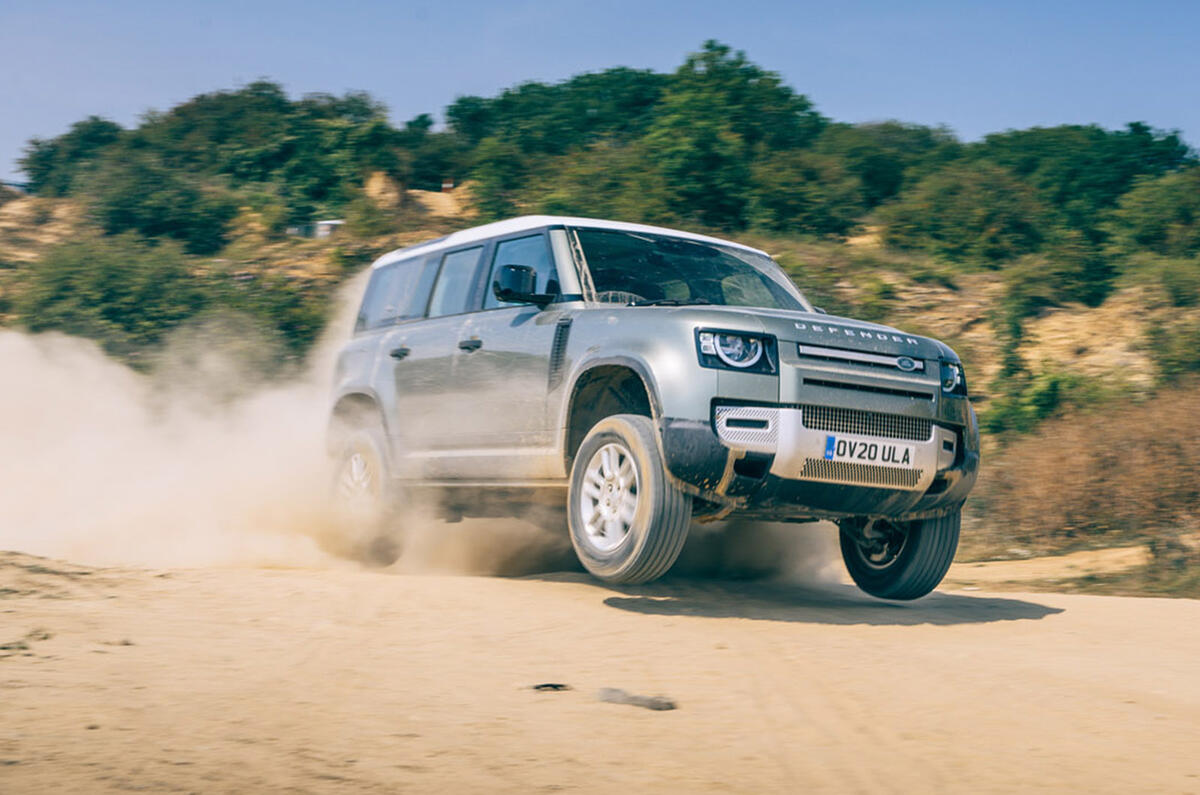











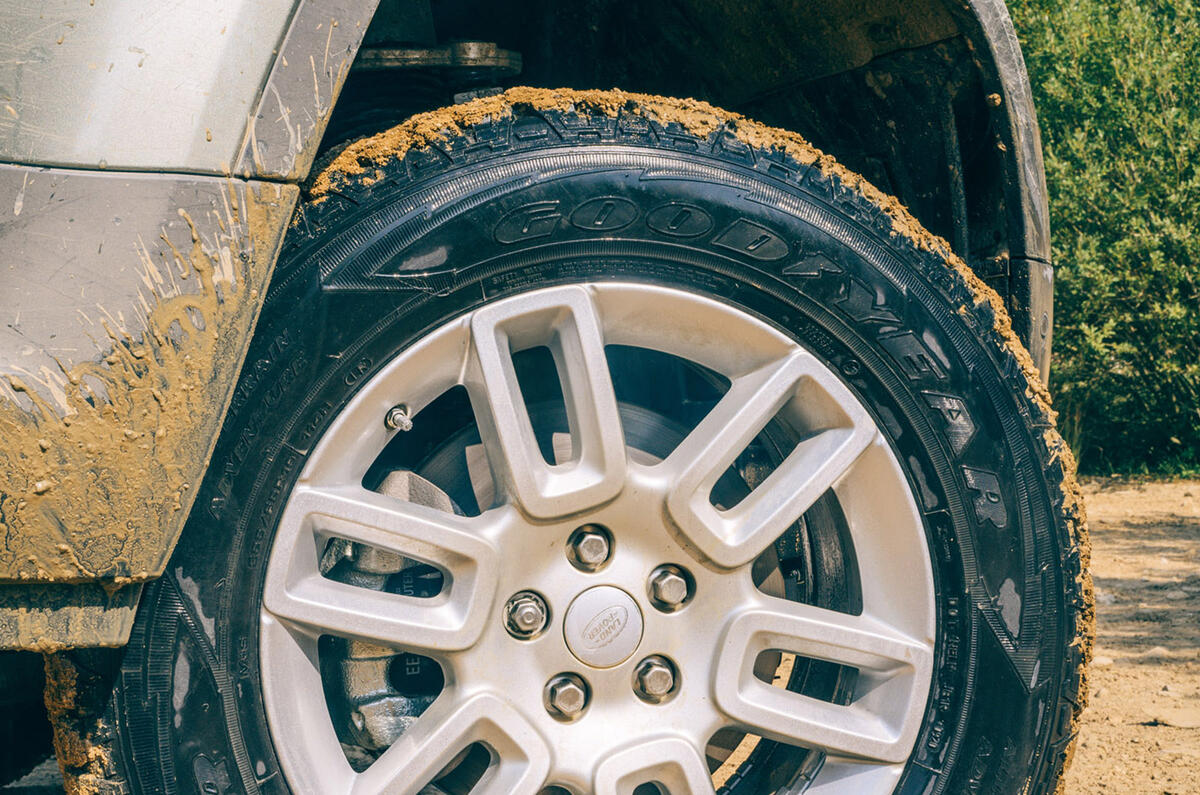
























Join the debate
Add your comment
A trio of Chelsea Tractors
Where is the tough, reliable yet comfortable and very capable Toyota Landcruiser?
These three will be in and out of garages, breaking down and needing expensive repairs for their short Kensington lives.
The Defender fails for 2
The Defender fails for 2 reasons.
1. It has the wrong type of chassis.
2. It is incredibly incredibly ugly. Gut churningly so.
SUV / 4x4 tax? YES that'd be
emmm
really, define suv, will an Audi tt Quattro have to pay it. Perhaps a sports car tax might be more appropriate
Tycoon wrote:
Why would we want to penalise the British car industry (Land Rover)? And why not have an Aston Martin or Roll Royce tax too? Neither make cars as efficient as say a foreign made fiesta?
.
You do post some complete and utter dribble. You are as bad as Symanski.